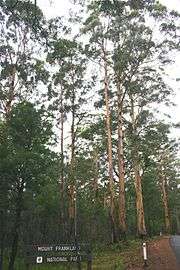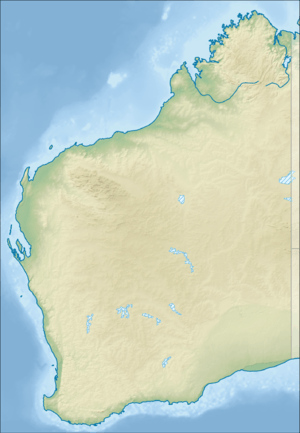Mount Frankland National Park
Mount Frankland National Park is a national park in the South West region of Western Australia, 327 km (203 mi) south of Perth. The park is part of the larger Walpole Wilderness Area that was established in 2004, an international biodiversity hotspot.[2]
| Mount Frankland National Park Western Australia | |
|---|---|
IUCN category II (national park) | |
 Mount Frankland National Park | |
 Mount Frankland National Park | |
| Nearest town or city | Walpole |
| Coordinates | 34°45′59″S 116°44′34″E |
| Established | 1988 |
| Area | 373.59 km2 (144.2 sq mi)[1] |
| Managing authorities | Department of Environment and Conservation |
| Website | Mount Frankland National Park |
| See also | List of protected areas of Western Australia |
Geography
It covers the low granite hills to the north of the town of Walpole and is covered largely by forests of karri (Eucalyptus diversicolor) and red tingle (Eucalyptus jacksonii), two of the world's largest trees. The three tingle species are unique to the area between the park and the coast and the only eucalypts to be buttressed, a feature which reflects the moist conditions prevailing within the park. On exposed areas where continuous rain washes away soil, a low heathland is the dominant vegetation.
Annual rainfall at Walpole is around 1,200 mm (47 in). On the 422-metre high peak of Mount Frankland, though no rain gauge has ever been installed, annual rainfall is probably around 1,500 mm (59 in). Most rain falls between May and August, but unlike drier parts of southwestern Australia, showers are not infrequent even during the summer.
See also
- Protected areas of Western Australia
References
- "Department of Environment and Conservation 2009–2010 Annual Report". Department of Environment and Conservation. 2010: 48. ISSN 1835-114X. Archived from the original on 11 January 2011. Cite journal requires
|journal=(help) - "Walpole wilderness". Walpole Community Resource Centre. 2014. Retrieved 13 December 2018.